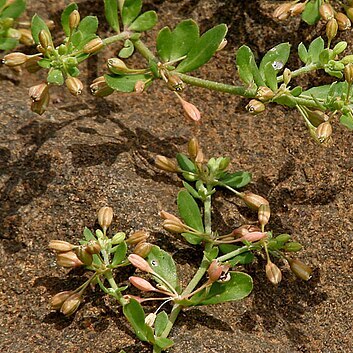Herbs annual, diffuse, procumbent, often much branched, with stellate or simple hairs or glabrous. Leaves alternate, or in pseudowhorls, margin entire or with sparse teeth. Inflorescences in seemingly axillary cymes. Flowers pedicellate or subsessile. Tepals 5, persistent, free, usually with white scarious margin, often yellowish on inner surface, often unequal. Petals absent or 1-8(-20), linear, often split at tips. Stamens (3-)5(-20), free or fascicled when numerous. Carpels 3(-5), connate; ovary ovate or oblong, 3(-5)-loculed; ovules numerous. Stigmas 3(-5), persistent, erect, spreading, or curved, linear or oblong-elliptic. Capsule ovoid or ellipsoid, 3-5-valved. Seeds numerous, reniform, each with a short funicle with a long filiform appendage, the strophiole, coiled around the seed; testa finely granulate or smooth.
Diffuse, glabrous or hairy, often much branched annuals. Leaves opposite or spuriously whorled, oblong, oval, ovate, obovate or spathulate, entire or obscurely dentate. Flowers axillary in few-flowered clusters or fascicles, pedicelled or sub-sessile. Tepals with scarious, frequently white margins, often unequal. Stamens 3-20, free or, when numerous, fascicled, in the Malaysian specimens usually 3-15 and free; filaments filiform. Ovary oval or oblong, 3-5-celled. Styles erect, spread-ing or recurved, linear or oblong-elliptic, persistent. Capsule 3-5-valved. Seeds ∞, distinctly strophiolate; strophiole with a long, thin appendix encircling a consider-able part of the seed and resembling a funicle but not attached to the placenta; testa finely granulate.
Often prostrate simply or stellately pubescent or almost glabrous somewhat succulent annual herbs. Leaves opposite or apparently verticillate, narrowly elliptic to almost orbicular, entire or serrate, shortly petiolate. Flowers fascicled at the nodes, axillary, pedunculate. Sepals 5, herbaceous, free. Staminodes 0–20 or more, usually divided at the apex, sometimes petaloid. Stamens 3–30 or more, free, hypogynous. Ovary superior, of 3–5 united carpels, 3–5-locular, the loculi multiovulate; placentation axile; stigmas sessile, free, as many as carpels. Fruit a 3–5-valved loculicidal capsule. Seeds granulate or smooth, each with a distinct long filiform-appendaged strophiole.
Herbs, annual, stellate, pubescent. Stems prostrate to ascending, branching from base. Leaves alternate or whorled; stipules absent. Inflorescences axillary, cymose; cymes dense, reduced. Flowers sessile or short pedicellate; sepals persistent, 5, basally connate, abaxially stellate-pubescent; petals absent (or 5-20); stamens (3-)5(-20), alternate with sepals, distinct or fascicled; pistils 3-5-locular; ovules 10-25 per locule; styles 1(-5), terminal, erect, or stigmas sessile. Fruits capsular, 3-5-valved. Seeds: somewhat flattened laterally, asymmetrically reniform, smooth to tuberculate, funiculus develops into a long, slender strophiole. x = 9.
Annual herbs, stellate-pubescent, subsucculent; branches ascending to procumbent. Leaves alternate, opposite or whorled, linear to orbicular, often unequal in size at a node; stipules absent. Inflorescences axillary, fasciculate or seemingly cymose, cymes sometimes verticillate or flowers solitary; flowers sessile or pedicellate. Sepals 5, sometimes apically appendaged or cleft; petals absent; stamens 3-20, free, staminodes 0-20, often petaloid and divided at apex; ovary 3-to 5-locular, ovules numerous in each locule, style 1, short, stigmas 5. Capsule loculicidal, thin-walled or membranous; seeds small, strophiolate, testa smooth or granular.
Often more or less prostrate, simply or stellately pubescent or almost glabrous, sometimes succulent, annuals or perennials with annual shoots.
Ovary superior, of 3 or 5 carpels, 3 or 5-locular, the loculi multi-ovulate; placentation axile; stigmas sessile, free, as many as carpels.
Seeds many, reniform, granulate or smooth, each with a fleshy aril on a long filiform-appendaged strophiole.
Leaves alternate, opposite or verticillate, narrowly elliptic to orbicular, entire or serrulate.
Staminodes 0–8 or more, usually divided at the apex, sometimes more or less petaloid.
Fruit a 3-or 5-valved loculicidal capsule.
Perianth segments 5, herbaceous, free.
Stamens 3–?, free, hypogynous.

